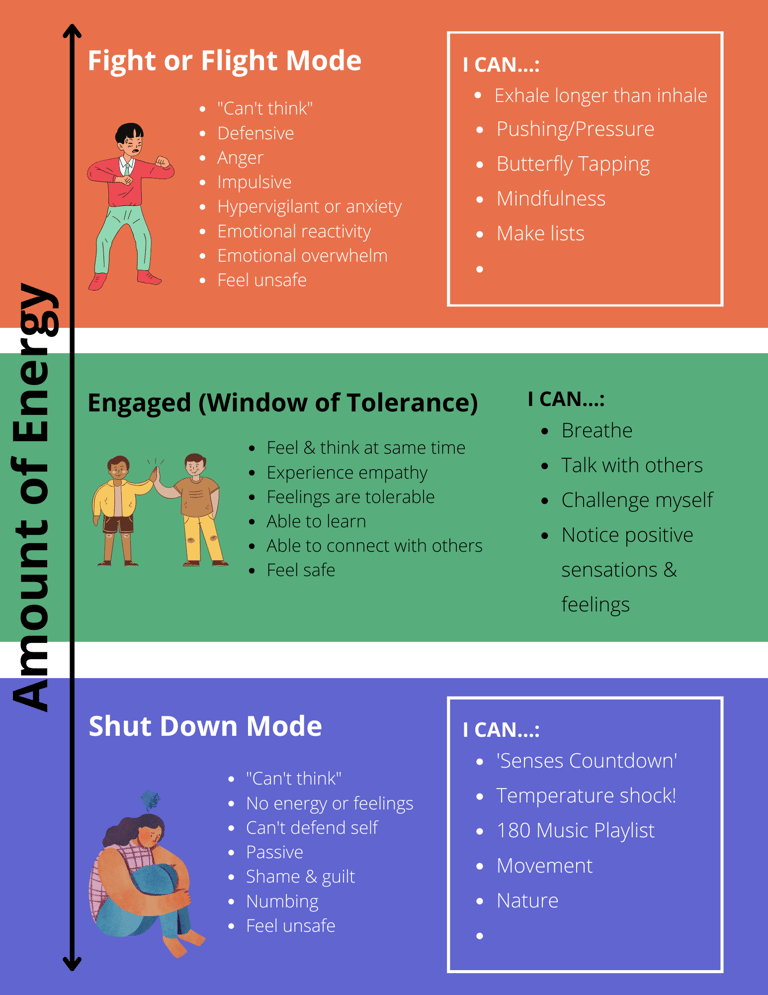Most people come to therapy because they want less of something: less panic, less anxiety, less stress, less disconnection. That makes sense, and therapy can absolutely help reduce suffering.
But therapy can also be about something more. It can be about growing your capacity for joy, play, connection, and presence. It can be about actually feeling safe enough to take in the good things when they show up.
This is where two models of the nervous system are really helpful: the Window of Tolerance and the Circle of Capacity.


What Is the Window of Tolerance?
The Window of Tolerance, developed by Dr. Dan Siegel, is a framework for understanding the relationship between our nervous system, its energy levels, and our behaviors (#1). When we are inside this window, we can stay grounded, flexible, and able to engage with life. We can think and feel at the same time. We can connect with others. We can experience emotions without being overwhelmed by them.
When we move above the window, we enter fight or flight mode. That might feel like anxiety, panic, racing thoughts, irritability, or defensiveness. At lesser degrees, this can also just look like activation or problem-solving—things we need every single day.
Here's a visual handout I created for my clients.
When we move below the window, we shut down. Some people call this the freeze state. That can look like numbness, collapse, exhaustion, or a sense of being disconnected from yourself and others. At lesser degrees, this is what allows us to rest or wind down for the evening.
Sometimes we can move in both directions at once. Fawning, or people-pleasing in order to appease someone who feels threatening, is a great example of this. One part shuts down, while another moves toward action and problem-solving to try to address the issue.
Everyone moves in and out of their window multiple times each day. It is part of being human. Therapy can help us widen the window so we spend more time in that blend between the two.
Giving Our Survival Responses Context
It is important to say this clearly: moving outside the window is not a failure. For many people, especially those living in hostile environments because of racism, immigration enforcement, homophobia, or transphobia, moving into fight, flight, or shutdown is actually adaptive and helpful for survival.
These are regular human survival responses. They help us get through situations that are unsafe. Gabes Torres, a brilliant thinker and therapist, describes this as a politicized Window of Tolerance (#2). She highlights how these states of nervous system activation can also support people as they organize politically or advocate for their communities. This politicized lens is important because it reminds us that the goal is not only to cope better, but to work toward creating conditions where people do not have to live with a chronic lack of safety in the first place.
Therapy is not about erasing those responses. It is about building the flexibility to come back into your window when it is safe enough to risk it.
That might be in your home, with people you trust, or even just for a short moment during the day.
While the Window of Tolerance is a great model, it does leave out some of the most crucial ingredients for mental well-being: joy and aliveness.
The Circle of Capacity: Integrating Joy and Aliveness
Dr. Cathy Malchiodi introduced the Circle of Capacity as an important addition to the Window of Tolerance (#3). While the window describes how much stress we can handle, the circle describes how much positive experience we can take in.
If you’ve experienced trauma, joy and closeness can feel just as overwhelming as stress. It can be hard to take in a compliment, to relax without bracing for something bad to happen, or to feel at ease even when someone has shown you they are safe enough to trust.
The Circle of Capacity reminds us that mental health isn’t only about handling distress. It is also about learning to stay present with good things. Expanding the circle means making more room for joy, connection, play, creativity, and aliveness.
So here is a question for you: when good things happen, do you lean in, or do you pull back?
If you notice yourself pulling back, that is not a failure. It is simply information. It tells us where your circle of capacity is right now, and that circle can grow.
How Therapy Can Help
The integration of joy and aliveness is at the heart of my work as a therapist. Too often, I’ve seen the mental health system focus only on reducing negative feelings and symptoms.
But life is so much more than not experiencing bad stuff. It’s about being with the good stuff too.
I draw from several approaches to help clients expand both their Window of Tolerance and their Circle of Capacity for joy and connection.
Internal Family Systems (IFS): This approach helps us get to know all parts of ourselves with compassion. When even our anxious or protective parts feel welcomed, it becomes safer to step into both challenge and joy.
EMDR (Eye Movement Desensitization and Reprocessing): EMDR helps the nervous system reprocess painful memories and patterns that keep us stuck in survival mode. By working through these, we make more room for presence and connection.
Skill-building: I also bring in practical tools from DBT, CBT, ACT, mindfulness, and somatic therapy. These skills help regulate emotions, strengthen awareness, and gently practice staying present with both discomfort and joy.
Together, these approaches help therapy become more than symptom reduction. They help create a bigger container for life.
Therapy is not only about feeling less bad. It is about expanding your ability to feel safe, joyful, and connected. It is about building a life where you are not just surviving, but able to enjoy the moments that matter most.
If you're interested in learning more or starting your therapy journey, reach out to Michael over email or you can schedule a free 15 minute consultation with him at this link: https://michaelzuch.com/book-consult-now
References
Siegel, D. J. (1999). The developing mind: Toward a neurobiology of interpersonal experience. Guilford Press.
Torres, G. (2024). Politicizing Siegel’s Window of Tolerance. Substack. https://gabestorres.substack.com/p/politicizing-siegels-window-of-tolerance?utm_campaign=post&utm_medium=web
Malchiodi, C. (2021). Traumatic stress and the circle of capacity. PsychologyToday Blog. https://www.psychologytoday.com/us/blog/arts-and-health/202109/traumatic-stress-and-the-circle-capacity
Image by Priscilla du Preez, Unsplash Creative Commons





